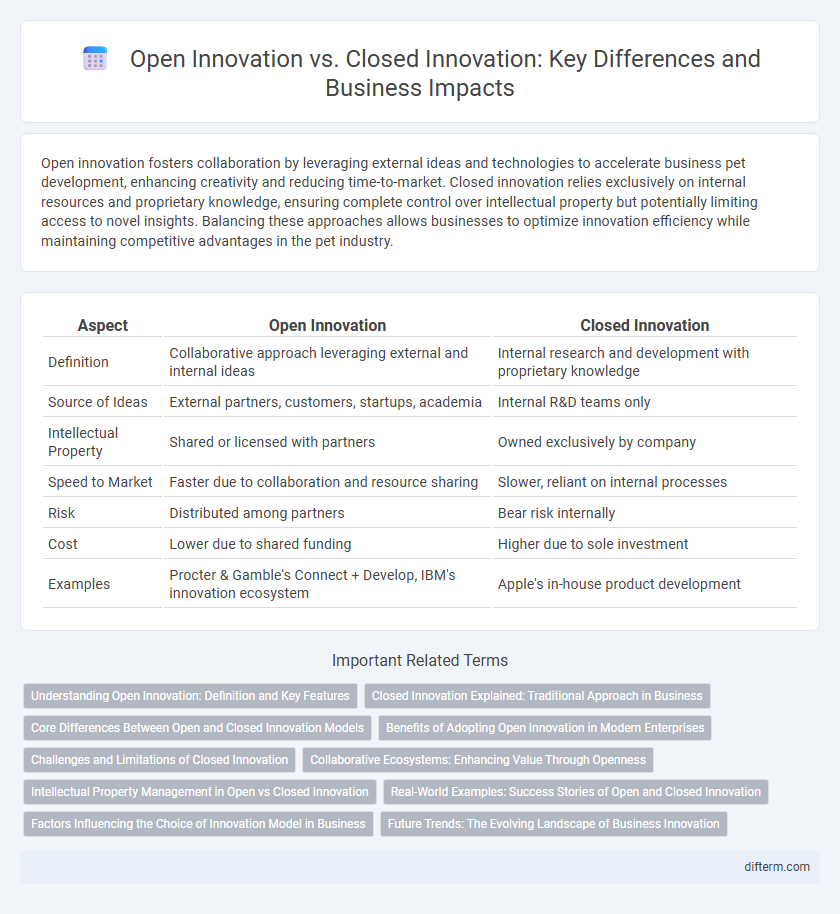Open innovation fosters collaboration by leveraging external ideas and technologies to accelerate business pet development, enhancing creativity and reducing time-to-market. Closed innovation relies exclusively on internal resources and proprietary knowledge, ensuring complete control over intellectual property but potentially limiting access to novel insights. Balancing these approaches allows businesses to optimize innovation efficiency while maintaining competitive advantages in the pet industry.
Table of Comparison
| Aspect | Open Innovation | Closed Innovation |
|---|---|---|
| Definition | Collaborative approach leveraging external and internal ideas | Internal research and development with proprietary knowledge |
| Source of Ideas | External partners, customers, startups, academia | Internal R&D teams only |
| Intellectual Property | Shared or licensed with partners | Owned exclusively by company |
| Speed to Market | Faster due to collaboration and resource sharing | Slower, reliant on internal processes |
| Risk | Distributed among partners | Bear risk internally |
| Cost | Lower due to shared funding | Higher due to sole investment |
| Examples | Procter & Gamble's Connect + Develop, IBM's innovation ecosystem | Apple's in-house product development |
Understanding Open Innovation: Definition and Key Features
Open Innovation is a business management model that encourages companies to use external ideas, technologies, and pathways alongside internal resources to accelerate innovation processes and create value. Key features include collaboration with external partners, leveraging intellectual property, and fostering a dynamic flow of knowledge across organizational boundaries. This approach contrasts with Closed Innovation, where all R&D activities and intellectual property developments occur strictly within the company's internal confines.
Closed Innovation Explained: Traditional Approach in Business
Closed innovation refers to a traditional business model where companies rely exclusively on internal resources, such as in-house R&D teams, to develop new products and technologies. This approach emphasizes confidentiality, intellectual property control, and proprietary knowledge to maintain competitive advantages within the market. Organizations using closed innovation typically limit external collaboration, focusing on leveraging their own expertise and assets for innovation success.
Core Differences Between Open and Closed Innovation Models
Open innovation leverages external ideas and collaborations to accelerate product development and market reach, contrasting with closed innovation that relies solely on internal resources and proprietary knowledge. Core differences include the flow of knowledge, where open innovation encourages sharing and external partnerships, while closed innovation maintains strict control over intellectual property and innovation processes. Companies adopting open innovation often experience faster innovation cycles and increased adaptability compared to the more siloed and slower internal development typical of closed innovation.
Benefits of Adopting Open Innovation in Modern Enterprises
Open innovation enables modern enterprises to accelerate product development by leveraging external ideas and technologies, significantly reducing time-to-market. It fosters collaboration across diverse stakeholders, enhancing creativity and access to a broader talent pool. This approach also mitigates risks and lowers R&D costs by sharing resources and expertise beyond organizational boundaries.
Challenges and Limitations of Closed Innovation
Closed Innovation often faces significant challenges such as limited access to diverse ideas and slower product development cycles. The restriction to internal resources can lead to innovation bottlenecks and higher costs due to lack of external collaboration. This approach may also result in missed market opportunities and difficulty keeping pace with competitors leveraging open innovation ecosystems.
Collaborative Ecosystems: Enhancing Value Through Openness
Collaborative ecosystems leverage open innovation by integrating diverse external expertise, accelerating product development and market responsiveness. Businesses engaging in open innovation benefit from shared resources, cross-industry partnerships, and collective problem-solving, driving superior value creation. In contrast, closed innovation limits these advantages, restricting growth opportunities and innovation potential within isolated organizational boundaries.
Intellectual Property Management in Open vs Closed Innovation
In business, Open Innovation encourages collaboration beyond company boundaries, requiring flexible Intellectual Property (IP) management strategies that balance sharing and protection to maximize value creation. Closed Innovation emphasizes strict IP control within the organization, prioritizing proprietary ownership and limiting external access to safeguard competitive advantage. Effective IP management in open innovation often involves licensing, joint ventures, and patent pooling, contrasting with internal patenting and trade secret protection common in closed innovation models.
Real-World Examples: Success Stories of Open and Closed Innovation
Procter & Gamble's Connect + Develop program exemplifies open innovation by collaborating with external partners to accelerate product development and drive market growth. In contrast, Apple's closed innovation approach centers on in-house research and strict control over product design, ensuring proprietary technology and cohesive user experiences. Tesla balances both models by leveraging open patents for electric vehicle advancement while maintaining proprietary software and hardware innovations internally.
Factors Influencing the Choice of Innovation Model in Business
Factors influencing the choice between open innovation and closed innovation models in business include the organization's risk tolerance, intellectual property strategy, and collaboration capabilities. Companies prioritizing control over proprietary knowledge often lean towards closed innovation, while those seeking diverse ideas and faster market entry favor open innovation. Market dynamics, resource availability, and competitive pressure also shape the decision by impacting the required speed and scope of innovation.
Future Trends: The Evolving Landscape of Business Innovation
Open Innovation is increasingly favored as companies leverage external ideas and collaborations to accelerate R&D and market adaptation, contrasting with the traditional Closed Innovation model that relies solely on internal resources. Future trends highlight the integration of digital platforms, AI-driven knowledge sharing, and cross-industry partnerships shaping the innovation ecosystem. Businesses adopting hybrid innovation strategies are likely to gain competitive advantages by balancing open collaboration with proprietary developments.
Open Innovation vs Closed Innovation Infographic

 difterm.com
difterm.com